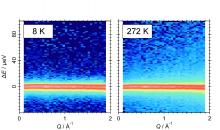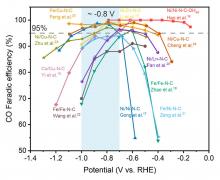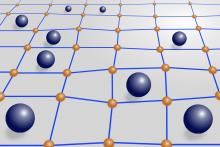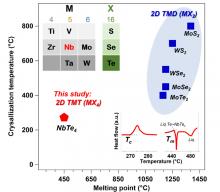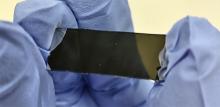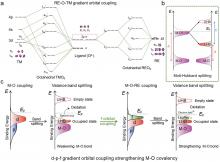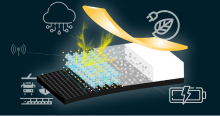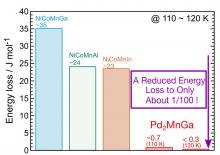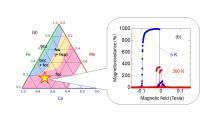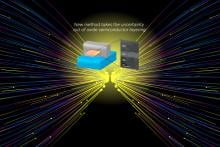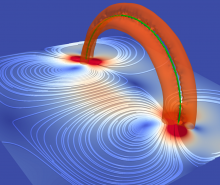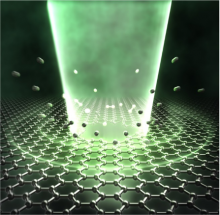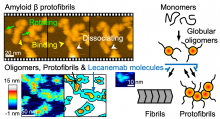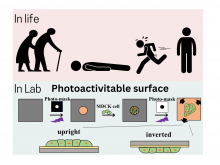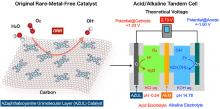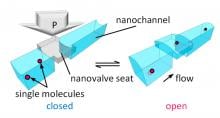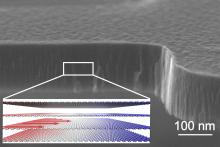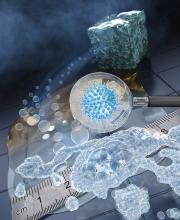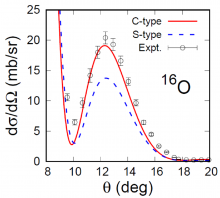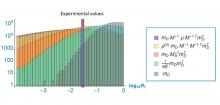Physics
News
26 Jul 2023
Researchers from Osaka University use quasi-elastic neutron scattering to get a close look at the behavior of water molecules in a semiclathrate hydrate crystal. They found that the molecules showed fast reorientation with an activation energy similar to that of cleaving a hydrogen bound. This rapid relaxation time in the solid electrolyte is expected to lead to efficient, cost-effective, and safe applications for semiclathrate hydrates in batteries and thermal storage materials.
26 Jul 2023
Researchers at Tohoku University have unraveled the reasons behind the underperformance of a promising field of catalysis known as dual atom catalysts (DACs). Their findings shed light on the challenges faced by DACs in converting carbon dioxide into valuable multicarbon products.
25 Jul 2023
Illuminating the molecular ballet in living cells, Charting the voyage of marine plastics, A glimpse into the origins of life & Earliest human journeys to Asia. Plus Submissions open for Asia Research News 2024. Read all in the latest Editor's Choice.
20 Jul 2023
Researchers from the Institute of Industrial Science, The University of Tokyo, provide physical insights into porous soft materials, which will facilitate the design of many energy, medical, and other technologies.
10 Jul 2023
Tohoku University researchers have engineered a new material that overcomes some of the barriers to furthering phase change memory – a potentially revolutionary form of data storage that is still in its infancy. Using sputtering, they created a 2D Van Der Waals Chalcogenide that possesses an ultra-low melting point.
30 Jun 2023
Topological materials’ unique properties make them a great choice for making next-generation devices. In order to exploit them, it was thought that crystalline materials, where atoms are highly ordered, were needed. But now, a research group has verified that even amorphous materials, where atoms are loosely arranged, can have these special properties.
19 Jun 2023
A key protein for sperm maturation identified, Understanding gel formation, Urine test predicts organ diseases, A laser drills holes in a graphene film. Plus in our blog - The frogs of Borneo: more than just a race. Read all in the latest Editor's Choice.
19 Jun 2023
Finding lost-cost and efficient means of accelerating the oxygen evolution reaction could lead to the proliferation of water-splitting electrolyzes. Rather than adopting a time-consuming trial and error approach, an international research group has used theoretical predictions to identify and then successfully fabricate a new electrocatalyst.
15 Jun 2023
An international research group has engineered a new energy-generating device by combining piezoelectric composites with carbon fiber-reinforced polymer (CFRP), a commonly used material that is both light and strong. The new device transforms vibrations from the surrounding environment into electricity, providing an efficient and reliable means for self-powered sensors.
14 Jun 2023
A physicist from the University of the Philippines – Diliman College of Science National Institute of Physics (UPD-CS NIP) led a team of researchers in pioneering a way to make a special kind of “dark” matter that can’t be observed using standard laboratory methods.
13 Jun 2023
Metamagnetic shape memory alloys (MMSMA) have negated some of the common problems associated with shape memory alloys thanks to their ability to undergo phase transformation when exposed to an external magnetic field. Yet they still lose a large amount of energy when phase transforming. Now, a research group from Tohoku University has made a significant breakthrough, developing a palladium-based MMSMA that exhibits low energy loss.
09 Jun 2023
With the need for hardware to process large amounts of digital information ever growing, researchers are working hard to improve magnetoresistive devices. The magnetoresistance ratio indicates the efficiency of these devices, the higher the better. Most magnetoresistive devices comprise magnesium oxide and iron-based magnetic alloys. But a group of researchers from Tohoku University has unveiled a new material that also exhibits enormous magnetoresistance.
09 Jun 2023
Researchers from Institute of Industrial Science, The University of Tokyo develop a nanosheet oxide semiconductor for electronic devices
06 Jun 2023
Ultrafast fluorescent imaging technology brings the molecular dynamics of living cells into clear view.
31 May 2023
Osaka Metropolitan University scientists investigated numerically the interaction between a quantized vortex and a normal-fluid. Based on the experimental results, researchers decided the most consistent of several theoretical models. They found that a model that accounts for changes in the normal-fluid and incorporates more theoretically accurate mutual friction is the most compatible with the experimental results.
26 May 2023
Graphene has revolutionized materials science since its discovery in 2004, with its high electron mobility, mechanical strength, and thermal conductivity. But processing graphene at the micro/nanoscale is a challenging process that often involves large-scale equipment and complex operations. Now, Tohoku University researchers have applied their simple femtosecond laser technique to ultra-thin atomic layers of graphene, resulting in multi-point hole drilling without damaging the graphene film.
23 May 2023
Researchers from the Institute of Industrial Science, The University of Tokyo, discover how certain colloids can form a solid-like gel and reveal how the mechanism differs from glasses.
15 May 2023
Researchers at Kanazawa University report in Nano Letters how high-speed atomic force microscopy leads to insights into processes relevant to Alzheimer’s disease. Moreover, the technique is shown to be an excellent tool for studying the effect of drugs against the disease.
12 May 2023
Specially coated surfaces help scientists investigate what happens when cell clusters are turned upside down.
12 May 2023
An international research group has developed a new surface coating technology that is capable of significantly increasing electron emission in materials. Their breakthrough is expected to improve the production of high-efficiency electron sources, and lead to increased performances in electron microscopes, electron beam lithography systems, and synchrotron radiation facilities.
09 May 2023
Zinc-air batteries may power the future thanks to their high density, low cost, and nature-friendly makeup. Yet, their low voltage has stymied their widespread application. Now, a research group has realized a zinc-air battery with an open circuit voltage of over 2 V.
01 May 2023
A joint research group at Osaka Metropolitan University has succeeded in regulating the flow of single molecules in solution by opening and closing the nanovalve mounted on the nanofluidic device by applying external pressure. The research group fabricated a device with a ribbon-like, thin, soft glass sheet on the top, and at the bottom a hard glass substrate having nanochannels and nanovalve seats. By applying external pressure to the soft glass sheet to open and close the valve, they succeeded in directly manipulating and controlling the flow of individual molecules in solution. They also observed an effect of fluorescence signal amplification when single fluorescent molecules are confined in the tiny nanospace inside the valve. The effect can be ascribed to the nanoconfinement, which suppresses the random motion of the molecules.
26 Apr 2023
Researchers at the Institute of Industrial Science, The University of Tokyo, have developed a desktop charger with voltages high enough to replenish the electric charge on N95 and surgical masks, which is required for effective use
20 Apr 2023
Researchers at the Institute of Industrial Science, The University of Tokyo use isotopically purified graphite to study the phenomenon of heat flowing like a fluid, which can lead to new heat-sink devices for electronics.
19 Apr 2023
In the quantum world particles can instantaneously know about each other’s state, even when separated by large distances. This is known as nonlocality. Now, A research group has produced some interesting findings on the Hardy nonlocality that have important ramifications for understanding quantum mechanics and its potential applications in communications.
17 Apr 2023
Asia Research Newsは同所の女性研究者5名に、彼女らの研究について、そしてなぜKavli IPMUを選んだのか、これまでの同所での経験について話しを聞いた。それぞれ様々な背景を持ち、各分野で卓越している研究者らに、足かせのない女性がいかに飛躍できるかをみせてもらった。
14 Apr 2023
We typically think of robots as metal objects, filled with motors and circuits. But the field of molecular robotics is starting to change that. Like the formation of complex living organisms, molecular robots derive their form and functionality from assembled molecules stored in a single unit, i.e., a body. Yet manufacturing this body at the microscopic level is an engineering nightmare. Now, a Tohoku University team has created a simple workaround.
13 Apr 2023
A research group at Osaka Metropolitan University has succeeded in selectively recovering trace rare earth elements in synthetic seawater and environmental water, such as hot spring water, using baker’s yeast with a phosphate group added. The phosphorylated yeast is expected to be utilized as a material for recovering useful metals and removing toxic metals, thereby contributing to the realization of a metal resource-circulating society.
12 Apr 2023
Osaka Metropolitan University scientists have developed a theory to experimentally determine differences in nuclear structure. Using this method to assess carbon and oxygen nuclei revealed that they contain more components in their cluster structure than in their shell structure. This enables visualization of nuclear structures without large-scale numerical calculations, which are expected to be applied to heavier nuclei in the future. This suggests that the method could be used to solve the ultimate question in nuclear physics: where did the elements we see around us come from?”
04 Apr 2023
Osaka Metropolitan University scientists analyzed each element of the neutrino mass matrix belonging to leptons and showed theoretically that the intergenerational mixing of lepton flavors is large. Furthermore, by using the mathematics of random matrix theory, the research team was able to prove, as much as is possible at this stage, why the calculation of the squared difference of the neutrino masses are in close agreement with the experimental results in the case of the seesaw model with the random Dirac and Majorana matrices. The results of this research are expected to contribute to the further development of particle theory research, which largely remains a mystery.
Events
Sorry, nothing coming up for this discipline
Researchers
Sorry, nothing coming up for this discipline
Giants in history
Sorry, nothing coming up for this discipline


